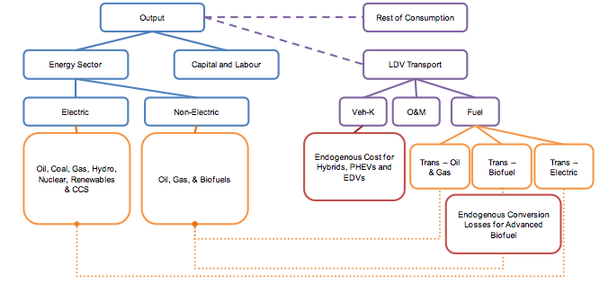Transport - WITCH
| Corresponding documentation | |
|---|---|
| Previous versions | |
| Model information | |
| Model link | |
| Institution | European Institute on Economics and the Environment (RFF-CMCC EIEE), Italy, http://www.eiee.org. |
| Solution concept | General equilibrium (closed economy) |
| Solution method | Optimization |
| Anticipation | |
The transport sector is part of the non-electric sector.
Light Duty Vehicles
WITCH model has been designed to incorporate a range of competing vehicle types to assist in the determination
of the dominant modes of light duty vehicles LDV transport that will tend to be selected to adequately satisfy demand for mobility.
Transport has been included in the model through the incorporation of the impact of investments in LDVs and fuel expenditures on the level of consumption. This means that increased LDV travel (in terms of kilometres travelled per vehicle) as well as the costs of the vehicle and fuel expenditure directly impact utility through the corresponding effect of decreasing consumption on other goods and services.
Demand for vehicles is set exogenously based on the assumption that constant travel patterns correspond to given levels and growth rates of GDP and population. This assumption is important as the demand for private transport will likely continue to be high and have a strong correlation with national income, unless a significant change in the way public transport is provided occurs.
The possibility of introducing a "Travel Elasticity Switch" and a ?"Vehicle - ownership Elasticity Switch" provides feedback effects which test the sensitivity of these constraints ( these elasticity impacts will be reviewed in future and are not imposed within this analysis ). Figure 3.3.1 shows the transportation module within the WITCH model structure. As noted, the model separates consumption in transport from the rest of consumption, which allows for the direct modelling of the costs involved in switching between vehicles and fuels for a given demand of mobility. Investments in vehicle capital and supplementary costs decrease the level of consumption. A Leontief production function (LDV Trans in Figure 3.3.1) represents the fixed proportions of operation & maintenance (O&M) costs, fuel and investment cost required for each technological type. Fuel demand and fuel category depend upon the vehicle chosen.
